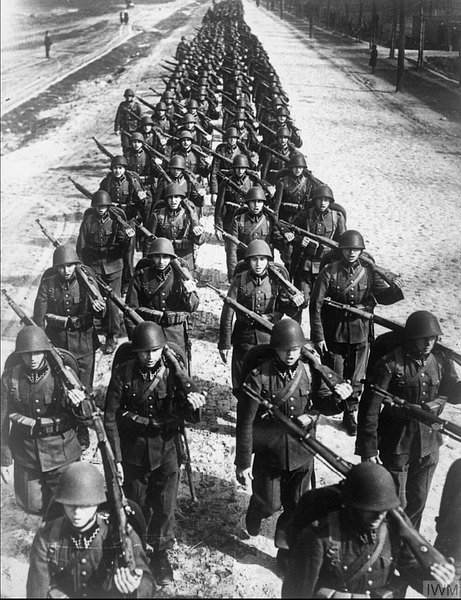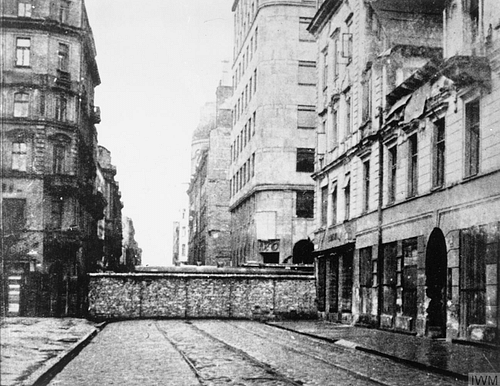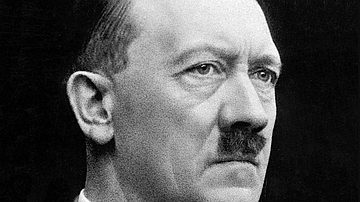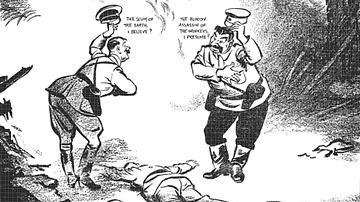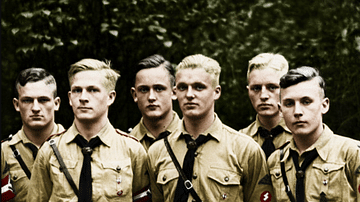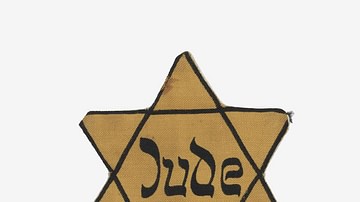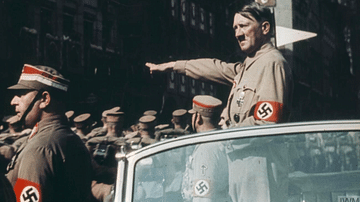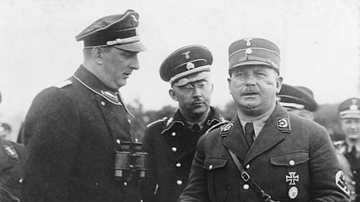The leader of Nazi Germany Adolf Hitler (1889-1945) ordered the invasion of Poland on 1 September 1939. Hitler's refusal to withdraw brought a declaration of war from Britain and France on 3 September, and so began the Second World War (1939-45). The USSR invaded eastern Poland on 17 September, and the country was divided and occupied by two totalitarian regimes.
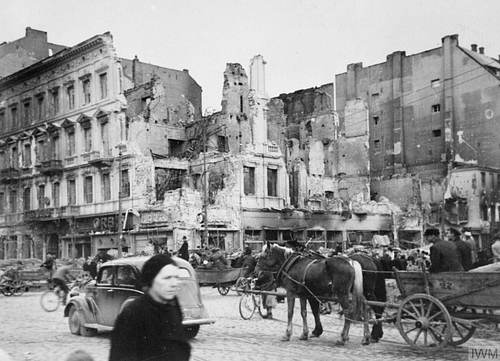
Hitler's Aggressive Foreign Policy
To understand why Poland became the country Britain and France decided to go to war over, it is necessary to trace the path of Germany's expansion from 1935. Adolf Hitler gained power in 1933, and two years later, he began a series of land grabs, each time using a combination of military manoeuvres, diplomacy, and bluff to convince world leaders that each new step into neighbouring territory would be his last. Hitler had promised the German people he would regain the territories lost after the First World War (1914-18) in the humiliating Treaty of Versailles (1919). Hitler said Germany needed Lebensraum ('living space') for its people, that is, new lands where they could prosper.
In March 1935, Hitler took back the coal-rich Saar region on Germany's western border, an area that had been governed by the League of Nations (the forerunner of today's United Nations) since the end of WWI. In March 1935, voters in the Saar decided overwhelmingly to rejoin Germany. Hitler, encouraged by the lack of an effective international response to Japan's invasion of Chinese Manchuria in 1931 and Italy's invasion of Abyssinia (Ethiopia) in 1935, next occupied the Rhineland, an area between Germany and France which the Versailles Treaty had stipulated must remain demilitarised. German troops entered the Rhineland in March 1936. Hitler then formally repudiated the Treaty of Versailles and embarked on a programme of rearmament. In 1936, he made an alliance with Italy, the Rome-Berlin Axis. In March 1938, Hitler occupied Austria, the country of his birth. The Anschluss ('fusion') with Austria was later endorsed by a plebiscite.
Next, Hitler wanted the Sudetenland, a neighbouring region of Czechoslovakia that had a German-speaking majority. Even though France and the USSR had signed a treaty in 1935 promising to protect Czechoslovakia from outside aggression, neither was willing to go to war when it came to the crunch. The majority of the population of Britain, like in France, was against the idea of a war and even against the policy of rearmament. At the Munich Conference of September 1938, Britain, France, Italy, and Germany met. In the Munich Agreement, the four powers agreed the Sudetenland would be handed over to Germany. The governments of Czechoslovakia and the USSR had no say in the matter. Hitler had promised to respect what remained of Czechoslovakia, but this he did not do, instead, he promoted the separation of Slovakia and invaded Bohemia and Moravia in March 1939. In the same month, Germany seized Memelland in Lithuania. In April, the fascist dictator in Italy, Benito Mussolini (1883-1945), occupied Albania. It was now clear to even the most naive of diplomats that nothing Hitler or Mussolini signed could ever be trusted.

The Failure of Appeasement
Throughout this turbulent period in European geopolitics, the United States remained isolationist. Britain, led by Neville Chamberlain (1869-1940), and France, led by Edouard Daladier (1884-1970), were both desperately keen to avoid the horrors of another world war, a conflict they were nowhere near militarily prepared for. The USSR, after the Bolshevik revolution and the purge of the Red Army by the Soviet leader Joseph Stalin (1878-1953), was not trusted by any of the other powers. Mussolini was also pursuing an aggressive foreign policy, which ignored the rights of other nations.
With hindsight, it is possible to see that Hitler was continuously looking for new territory to grab and only war would stop him, but this was not so clear at the time. Hitler was a master of duplicitous diplomacy, saying one thing and doing another, promising peace in one speech while threatening invasion in another, and generally bamboozling foreign leaders. Some historians believe Hitler had no definite strategy at all. He may not have had a clear plan on where, when, and how to expand the Third Reich, but he certainly seized his opportunities to take advantage of the diplomatic mistakes made by the Great Powers. By 1939, the picture of just what Hitler was up to was becoming ever clearer.
On top of the increasing mistrust of Hitler, there was, too, an increasing awareness of the Nazi regime's treatment of Jewish people – such as the Kristallnacht pogrom of November 1938 – which changed many minds that even if Hitler could be trusted, he was not someone whose favour should be courted. The tide was turning. When Hitler threatened Poland, the policy of appeasement was terminated. Appeasement had failed, but it had, at least, bought time for nations to arm themselves in readiness for what seemed, ever since 1938 and Munich, a war that would come sooner rather than later. The minority who had argued all along against appeasement, which included such figures as Winston Churchill (1874-1965), the future British prime minister, now pushed for a massive rearmament.
The Polish Question
The Polish borders were hotly disputed and had been for some time. The Treaty of Versailles had awarded Poland control of Upper Silesia (an industrialised region located between southern Germany and Poland) and a strip of land that gave the country access to the Baltic Sea. This strip, which had a population with a Polish majority, was called the Polish Corridor. The unfortunate result of the corridor was that it entirely cut off East Prussia from the rest of Germany. Danzig (Gdánsk), which had a population that was 90% German, had been made an autonomous Free City controlled by the League of Nations, but with its foreign policy and customs arrangements governed by Poland. The corridor and Danzig were probably the most resented of all the victors' geographical reshuffles. Hitler now set his sights on redressing this particular 'grievance'. Hitler had signed a non-aggression pact with Poland in January 1934, but his real intentions became evident in 1939.
The Great Powers Make Their Move
In March 1939, shortly after Hitler's occupation of Czechoslovakia, the Nazi dictator called for Poland to hand over Danzig and provide Germany with a land route (road and rail) across the Polish Corridor to connect with East Prussia. The Polish government refused. On 31 March, the British government, now fully realising Hitler could not be trusted after he had broken the Munich Agreement, declared it would guarantee Poland's present borders. France had already signed a treaty with Poland in 1921. Britain and France's bold promise, was, in reality, rather an empty one since the geography involved meant neither state could do much to prevent a German invasion of Poland, but it was hoped that a political guarantee would be enough to stop Hitler from grabbing yet another neighbour. It was a false hope. Hitler, enraged at the news, shouted at his army chiefs "I'll cook them a stew they'll choke on!" (Shirer, 467).
In April-May 1939, Hitler informed his generals they must prepare an invasion plan to attack Poland, code name: Case White. Britain and Poland signed a Mutual Assistance Pact on 25 August, formalising the verbal guarantee given in March. The treaty promised British aid if Poland were attacked but, crucially, did not stipulate Britain would guarantee Poland's borders as they were at the time. In response to the treaty, Hitler repudiated his own treaty with Poland signed back in 1934. The USSR had signed a non-aggression pact with Poland in 1932, but that would turn out to be a useless bit of paper, too.
Hitler began to prepare the ground for war by solidifying his links with Mussolini. At the Munich conference, the pair of dictators had already agreed to stand side by side when war did finally come. On 22 May 1939, Italy and Germany signed a military alliance, the 'Pact of Steel'. Then came a devastating blow to Britain and France, the price they had to pay for their lack of trust in Stalin and the Communist Soviet Union. On 23 August 1939, Germany signed a non-aggression pact with the USSR, the Molotov-Ribbentrop Pact (Nazi-Soviet Pact), named after the foreign ministers of each state. Stalin, who saw at Munich that Britain and France were not prepared to defend the nations to the east of Germany, rejected the idea of 'collective security', that is Britain, France, and the USSR working together to box in Germany on both sides.
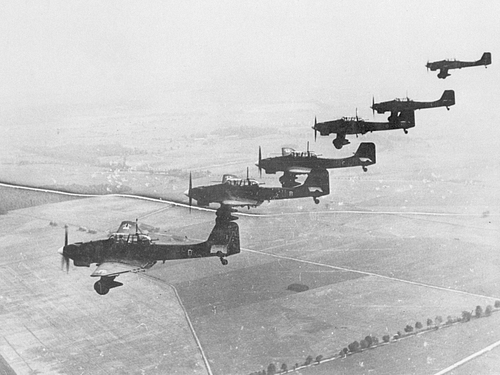
The only non-agression part of the Nazi-Soviet Pact was the promise that the two nations would not attack each other. Meanwhile, secret protocols in the agreement allowed Germany and the USSR to attack their neighbours, effectively carving up Central Europe between them. The pact allowed Stalin to grab eastern Poland and keep the USSR out of any war for a while, gaining precious time for rearmament. Perhaps, too, the possibility for Germany to wage war only in the West against Britain and France – Stalin's 'blank cheque' for Hitler – would sufficiently weaken all three so that they could no longer threaten the USSR. The Nazi-Soviet Pact, then, redrew Central Europe in a plan of conquest that involved not only Poland but also Romania, Latvia, Lithuania, and Finland.
Invasion
Poland, with a population of around 35 million, had a multiparty political system, but the government had become increasingly authoritarian and military-dominated through the 1930s. The Polish armed forces in 1939 consisted of 280,000 men in the army, a navy of four destroyers and five submarines, and an air force with 400 aircraft. Unfortunately, all of these weapons were nowhere near as modern as those wielded by Germany.
On 29 August, Poland again refused to meet Hitler's demands on their country (Danzig and a link to East Prussia). German troops invaded Poland at 4:45 a.m. on 1 September 1939. Hitler had made no formal declaration of war. The pretext for the invasion was the Gleiwitz Incident of 31 August, a false flag exercise, where Germany claimed that Polish troops had attacked a German radio station just across the border. In fact, the attack was carried out by a German Schutzstaffel (SS) unit led by Alfred Naujocks. The six-man team had dressed themselves up as Polish soldiers. A known Polish sympathiser, Franciszek Honiok, had been arrested by the Nazi secret police, the Gestapo, the day before. Honiok's body, along with several others of concentration camp internees, was brought to the station and machine-gunned to make it seem like a brutal Polish attack on German territory. Naujocks, in a sworn affidavit at the post-war Nuremberg Trials, confessed to his role in the operation and its objectives.
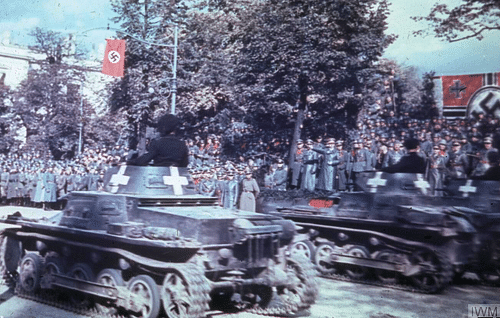
On 1 September, the German Army attacked on a wide front, overcoming stiff Polish resistance thanks to superior numbers, weaponry, and tactics. On 2 September, Chamberlain warned Hitler that war would follow if Germany did not withdraw. Hitler ignored the ultimatum. On 3 September, Britain and France, in order to protect not only Poland but all free and independent nations, declared war on Germany. The United States remained neutral. Italy, waiting in the wings to see what might happen to its advantage, remained neutral for the time being. There were many contributing causes of WWII, but the invasion of Poland was the last and most important. Privately, Hitler was stunned at the declaration of war, but, given military intelligence that the British General Staff considered Poland's army too weak to resist an invasion very long, he thought it highly unlikely Britain or France would involve their own troops directly; in this gamble, he was correct.
The Polish armed forces could not match Germany's technology or the strategy of blitzkrieg ('lightning war') which combined air power – notably the 'Stuka' Junkers Ju 87 dive bomber – with tanks and fast-moving infantry. At the same time, subversive activities behind enemy lines destroyed communications and transport networks, severely hampering the Polish Army's ability to respond to the invasion. Most of the Polish air force was destroyed on the ground by German bombers in the first two days. Kraków was captured on 6 September. Warsaw, the capital, surrendered on 27 September.
As Hitler attacked Poland, the opportunity to attack from the West, particularly by France, was lost. The entire German air force was employed against Poland, and the German Army simply could not have coped with an advance from France at the same time. Britain did nothing to help Poland either, like France, it felt unprepared as yet for a direct military confrontation. Meanwhile, Stalin lost little time, and, on 17 September, the Red Army marched into eastern Poland, claiming, rather implausibly, that they were merely entering to safeguard the future of Belorussian and Ukrainian Slavs inside Poland. As these two armies began to crush Poland, the Polish government fled the country and eventually set itself up in exile in London.
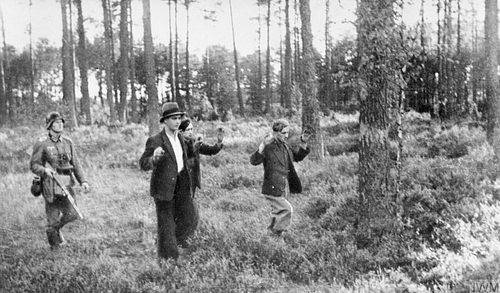
The Occupation of Poland
The armies of Germany and the USSR met more or less in the centre of Poland, dividing the country into two occupied areas. The main fighting ended by 7 October. 120,000 Poles had died defending their country. The split of Poland went down the line of the River Bug, but, as Germany's slice was slightly bigger, the USSR was permitted to do what it wanted with Lithuania. The new frontiers were recognised in the German-Soviet Treaty of Friendship, Co-operation, and Demarcation on 28 September. The USSR made client states of Estonia, Latvia, and Lithuania, although Finland stubbornly resisted the Red Army's attacks (a peace treaty was signed in March 1940). On 6 October, Hitler offered peace terms to Britain and France, but these were rejected.
The German half of Poland was divided into three parts, one area (roughly corresponding to what Germany had lost at the Treaty of Versailles) was incorporated into the Third Reich and given the name Wartheland. A second area, called the General Government, was to be used as little more than a labour colony. A third, small area in the far east was to be used as a sort of penal colony for any Nazi 'undesirables'.
Nazi Germany's rule in what had been western Poland was characterised by the building of walled ghettos for Jewish people, mass deportations, compulsory labour, the mass murder of those considered enemies of the state, and the burning of over 530 towns and villages. Special SS 'deployment groups' or Einsatzgruppen, were given free rein to murder at will. The SS operations were led by Reinhard Heydrich (1904-1942). The Einsatzgruppen units were ruthlessly efficient in their horrific extermination of civilians. "Within a week of the invasion, SS commanders were boasting of killing 200 Polish citizens a day and by 27 September Heydrich was able to report that only 3% of the Polish upper classes had survived" (Cimino, 116).
The Nazis made determined efforts to eradicate Polish culture. Germans were relocated to the new territory, the Polish language was banned, and over 200,000 children were forcibly sent to Germany in a systematic process of 'Germanization'. Polish cultural institutions, from theatres to libraries, were prohibited and monuments were destroyed. The intention was to dehumanize the entire Polish population in order to facilitate their use as forced labour and nothing more. Labour camps and concentration camps were set up everywhere in Poland, the most notorious being Auschwitz, where millions of Jewish people and other minority groups from across Europe were executed.
In the Soviet half of Poland, the Red Army captured over 200,000 Polish soldiers, many of whom ended up in prisoner-of-war camps or labour camps. The region was largely administered by Soviet or Soviet-sponsored civilians and incorporated into the USSR. There was, as in the German-controlled sectors, a brutal repression of anyone considered a threat to the new order. In just one notorious incident, 4,000 Polish army officers were executed in the Katyn Forest.
Large industries and farms were nationalised, the rouble became the new currency, and property was confiscated without any consideration to the rule of law. As in the German half, the administrators of Soviet Poland purposely set out to eradicate Polish culture. In schools, Russian, Ukrainian, and Belorussian became the permitted languages. Millions of men, women, and children were deported to work in the gulags, the USSR's forced labour camps. Around 30% of these people died either in transit or in the camps.
When Hitler turned to the east and attacked the USSR in Operation Barbarossa from June 1941, all of Poland came under German control. During WWII, 6 million Poles died. In the one bright spark of hope amongst this darkest of national disasters, tens of thousands of Poles in exile fought in the armed services of the Allies during the war, participating in all sorts of arenas from the North Africa Campaign to the Battle of Britain. In occupied Poland, there were, too, well-organized resistance movements, which conducted sabotage operations and which provided important military intelligence to the Allies such as Hitler's rocket programme. It is tragically ironic that, at the end of WWII, despite its freedom being one of the main causes of the conflict, Poland remained an occupied state. Stalin refused to hear all calls from the Western powers that Poland should be free, and the USSR took control of the country for the next five decades.
